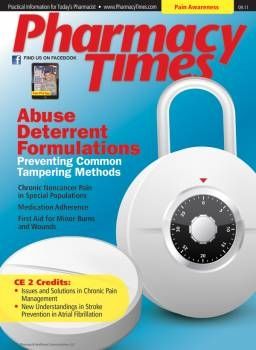Publication
Article
Pharmacy Times
Pain Management Watch
Smoking Linked to Chronic Pain
Individuals who smoke are far more likely to report problems with persistent musculoskeletal pain than nonsmokers, according to research published in the August issue of the Journal of Pain.
Michael D. Mitchell, MD, and colleagues from the University of Kentucky School of Public Health surveyed more than 6000 women to determine the association of smoking with the presence of different types of chronic musculoskeletal pain. Respondents were asked about pain symptoms and if they had been diagnosed with musculoskeletal pain disorders, such as fibromyalgia and low-back pain.
The study showed that smokers are significantly more likely to report chronic pain than nonsmokers. Daily smokers were twice as likely to report pain as nonsmokers, and individuals who smoke a pack or more a day also were most likely to report a high burden of chronic pain.
The authors noted that smoking-induced coughing increases abdominal pressure and back pain and nicotine may decrease pain thresholds by sensitizing pain receptors. The study also showed a dose-dependent relationship between smoking frequency and having chronic pain syndrome, which may indicate that smoking cessation treatments could be helpful for chronic pain management therapy.
Report Finds Increase in Opioid Abuse among Teens
Adolescents who misuse controlled medications for which they have a legitimate prescription may be more likely to abuse other substances and to sell, give, or trade their controlled medications to other individuals.
A report published in the August issue of Archives of Pediatrics and Adolescent Medicine found that more than 1 in 5 teens who are prescribed strong painkillers, stimulants, or other controlled medications by their physician take too much of the substances, risking dangerous side effects. The study also revealed that as many as 10% use the medications for recreational purposes.
“There has been an increase in the prescribing of controlled substances in the last 15 years, but there has also been an increase in the non-medical use of these substances,” said Sean Esteban McCabe, PhD, of the University of Michigan in Ann Arbor.
McCabe and colleagues conducted a survey of 2597 students in Michigan-based middle schools and high schools. Of the 18% of respondents who reported using a controlled medication for medical purposes during the past year, 22% also said they had misused these medications, mostly by taking too much. Frequent users of controlled medications were more likely than less-frequent users to engage in misuse. Prevalence of misuse was greater among frequent users of pain, sleeping, and anti-anxiety medications, and adolescents who misused their controlled medications were also more likely to use alcohol and other drugs and to divert these medications to others, the authors found.
“Despite the importance of controlled medications for the treatment of pediatric disorders, our results suggest that a consequence of the greater availability of these medications may be an increase in their nonmedical use,” McCabe and colleagues wrote. “Clinicians must balance the risks and benefits of controlled medication use with the abuse potential when assessing, treating, and monitoring their patients.”
The researchers also urge clinicians to “consider prescribing controlled medications with less potential for substance abuse and diversion.”
Study Finds Big Spike in Gout Prevalence
A new report finds that after a sharp increase over the past 2 decades, the prevalence of gout in the United States has soared to more than 8.3 million. Authors of the study, which was published July 28 in the journal Arthritis & Rheumatism, pinpoint rising rates of obesity and hypertension as a key factor.
Prior research found that incidence of gout—an inflammatory arthritis that causes severe pain and swelling—more than doubled in the United States from the 1960s to 1990s.
In the study, researchers analyzed data on nearly 6000 adults from the most recent US National Health and Nutrition Examination Survey (NHANES), conducted in 2007 and 2008, and compared it with data from 1998 to 1994. Results suggested that gout and hyperuricemia remain prevalent in the United States, and that cases of gout and hyperuricemia rose by 1% and 3%, respectively, over the past 20 years.
The authors also found that gout prevalence was higher in men (6%) compared to women (2%), and that hyperuricemia occurred in 21.2% of men and 21.6% of women.
“We found that the prevalences of gout and hyperuricemia continue to be substantial in the US adult population,” said Hyon Choi, MD, DrPH, of Boston University School of Medicine, the study’s senior investigator. “Improvements in managing modifiable risk factors, such as obesity and hypertension, could help prevent further escalation of gout and hyperuricemia among Americans.”






